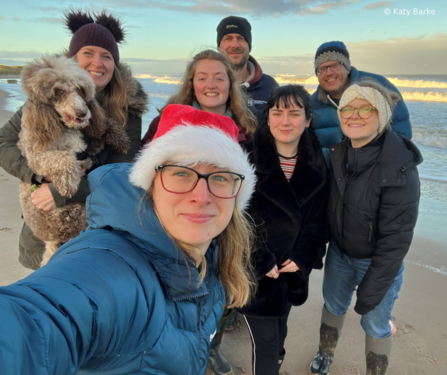
Nature Recovery Team, Christmas 2023. Photo by Katy Barke.

Nature Recovery Team, Christmas 2023. Photo by Katy Barke.
The Nature Recovery team is part of the wider NWT Conservation team and deal with a wide range of different work areas, mostly outside of our reserves. Headed up by Nature Recovery Manager Katy Barke, the team currently has eight members.
A snapshot of some of the work we do:
Our Wilding work is largely delivered by Graham Holyoak and Laura Hindle, who are planning and delivering our Wilder Northumberland and Wilder Druridge projects. Both of these projects involve speaking to local communities and landowners to help people make their area a bit wilder, for the benefit of people and nature. Watch this space for news of our new Wilder Northumberland Network which will be launching soon.
Within the Nature Recovery Team, Dan Chapman takes the lead on practical land management, supported by a fantastic team of dedicated volunteers. Much of Dan’s work takes places on land owned by Northumbrian Water, such as Whittle Dene and Bakethin Reservoir. Dan also delivers much of the work on Benshaw Moor.
The team has been involved in a number of species restoration and recovery projects. Some of our most high profile projects include:
We get involved with other species work too. Two of the key species that we are currently focusing on are water vole and pine marten, working with other organisations to develop and deliver to support the recovery of these and other species.
Local Wildlife Sites are areas of land with substantial importance to wildlife, identified and selected at a county level. Our team work with our local councils to survey and assess existing Local Wildlife Sites and identify potential new ones.
Where appropriate, we assess and respond to planning applications such as Woodland Creation Schemes and developments in priority areas, with this work being mostly covered by Conservation Assistant Sara Frisby.
Alice McCourt and Graham Holyoak are both qualified drone pilots, and have begun systematically surveying some of the Northumberland Wildlife Trust sites using our drones. We are also sometimes able to offer our services to other organisations.
A key role of the Nature Recovery Team is to support colleagues across the wider Trust and to contribute to developing future projects and funding bids.
Our Data Assistant Emily Frith has been tasked with taking charge of our species data and has been digitising historic records and supporting various projects with their data needs. Emily provides data support to our Red Squirrels Northern England Team.
A huge amount of our work is delivered in partnership, with key partners including Forestry England, Northumbrian Water and Northumberland County Council. Members of the team sit on a number of steering groups across the county, working closely with a wide number of different organisations.
Hopefully this has given you a very short introduction to the purpose of the Nature Recovery Team, although it’s difficult to capture everything that we are involved with! Keep an eye out for future posts exploring some of these themes in more detail.